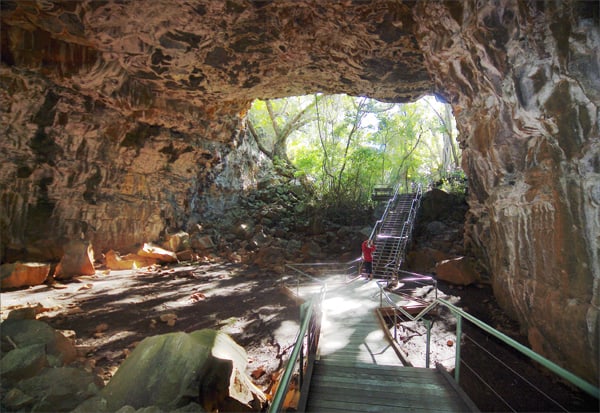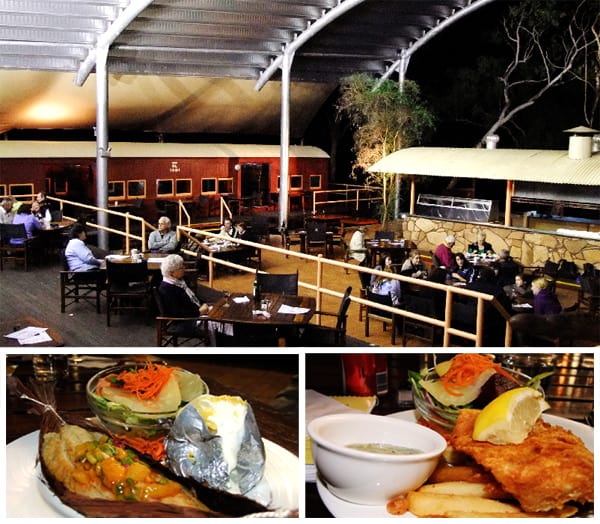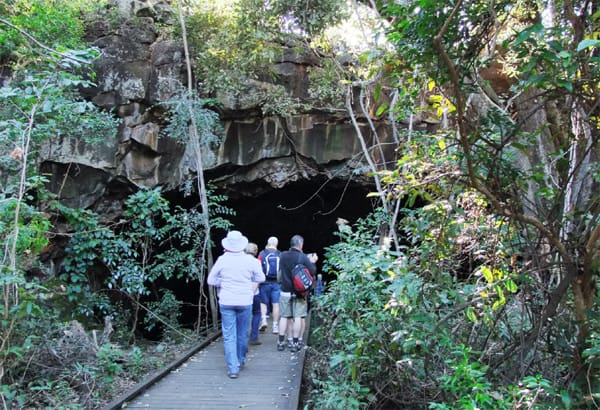Not far off the beaten track in Tropical North Queensland is one of the best kept secrets of the subterranean – a maze of lava tubes – all that remains of a spectacular volcanic eruption which occurred around 190,000 years ago in pre-historic inland Australia.
The place is Undara which, in local aboriginal dialect means, ‘a long way’ and it is a good hike – some 275 kilometres south west by road – from Cairns, the capital of the Tropical North. Undara is an unique village set in what was a former cattle station owned by the Collins family since 1862. Six generations of the Collins family have explored these remarkable natural phenomena created when, after a series of volcanic eruptions, the sides of the lava flow cooled allowing the centre to continue to flow, eventually draining out leaving large cavities and of considerable length.
Some 190,000 years ago, the Undara Volcano was around 1020 metres above sea level however the actual volcano is now less than 20 metres high. While 23 countries around the world can lay claim to the existence of lava tubes, the Undara Lava Tubes are amongst the longest in the world and are known to stretch more than 90 kilometres to the north and 160 kilometres to the north-west. Geologists estimate that 23 cubic kilometres of lava, at a temperature of 1200 degrees Celsius, flowed from the volcano at an amazing rate of 1000 cubic metres every second. It surely must have been a spectacular explosion dwarfing even the more recent explosions of Krakatoa – perhaps the world’s most well known volcano.
Seismic activity has long ceased, however the reminders of the volcanic era attract thousands of visitors each year to this remote outback location. Records are a little sketchy as to who actually discovered the Undara Lava Tubes – local aboriginals knew of their existence and the explorer Leichhardt mentioned their existence in his journals when he passed through the area in 1845. However, it was the Collins family who have given such prominence to this wonderful subterranean occurrence.
The Undara ‘Experience’ is a description given to a visit to this subterranean wonderland. It all starts with a visit to Undara Central, an unique village developed around 23 antique railway carriages and set in superb Savannah bushland. The development of the Undara village and the experiences offered during a visit to the place is largely as a result of the foresight of a fourth generation member of the Collins family, Gerry Collins. His forebears had settled the area in the early 1860s establishing Rosella Plains Station.
Gerry Collins was perhaps a man before his time. He recognised the significance of the lava tubes found on Rosella Plains, a cattle property of some renown. Collins’ vision was to make the lava tubes accessible to everyone and in 1987, he applied to develop a tourist facility on the station, along the original Cobb & Co coach road to places north of Undara.
Working closely with regional and state government authorities, Gerry Collins had proposed that a national park be gazetted around the lava tubes and tours be conducted under the watchful eye of the trusted Savannah Guides. The departure point for these tours would be ‘Undara Central’, an accommodation village established specifically to allow visitors to stay on the national park. The Collins family ceded some of their property to the State Government allowing for the gazettal of the Undara National Park. In turn, the Collins Family were granted rights to operate a tourist and accommodation facility in the park.
Gerry Collins’ idea of creating an unique accommodation experience began when he discovered some de-commissioned Queensland Railway carriages on a siding at Mareeba on the nearby Atherton Tableland. Collins purchased the 11 carriages and has since added to that number with a total of 23 carriages fully restored and situated on the old coach track. The period carriages have been beautifully restored with bathrooms and toilets at each end of the carriages. It is a superb achievement.
The Collins family also created Undara Central, a restaurant and bar facility, reminiscent of a 1900s railway station where meals can be enjoyed under the massive curved corrugated iron roof stretching between carriages or enjoy a meal in a dining carriage. The menu has been constructed to be reminiscent of fine railway fare, with a touch of the tropics and the vast array of fresh produce available.
Such is the flexibility of Undara village that visitors can elect either to visit for a day, stay in the beautiful restored rail carriages, camp on the grounds, bring a caravan or motorhome or stay in the Stockman’s Quarters – a dormitory style accommodation facility designed specially for the budget traveller.
We’d been further west and as distances are often substantial between towns and places of interest, we arrived at Undara well after sunset. Approaching the village in darkness gave a magical insight into what had been achieved in the creation of the Undara Experience. The lights from the railway carriages illuminated the shaded areas which clearly gave the impression of a train stopped amongst the trees. We made our way to Undara Central and enjoyed a meal in the train station-like amphitheatre – the heart of the village that is known as Fettlers Iron Pot Bistro.
Next morning and in keeping with the bushland setting of the village, we enjoyed a Bush Breakfast – another not-to-be missed experience. A real hearty country breakfast – billy tea brewed over a camp fire and toast made on camp coals.
The popularity of Undara has to be seen to be believed. After breakfast, there is an assembly of guests wishing to participate in one of the many tours on offer to the lava tubes. These tours range from two to eight hours and cater for every level of fitness, including mobility impaired as well as curiosity levels. The number of people assembled gives an idea of the overall capacity and size of the place – there were literally hundreds of visitors to the site.
Guests and day visitors are then marshalled into tour groups and briefed by the extremely knowledgeable Savannah Guides. It is important to note that there is no general access to the national park. All visits must be made under the auspices of the Savannah Guides.
Mini buses take each group on their specific tour. We had chosen the Archway Explorer tour and it proved to be a good choice.
National Parks have constructed a series of boardwalks and ramps providing safe access to and through the lava tubes. We enjoy a short 15 minute bus ride to the commencement point of our tour, the entrance to the Road Tube. During that time, our Savannah Guide gives us a history lesson of the region. It seems that the Undara Volcano is located on what is termed the McBride Volcanic Precinct.
In that precinct, there are a known168 volcanoes and vents, Undara being amongst the most significant. Here, volcanic activity raged from eight million years ago through to as recently as just 10,000 years ago. Some of the granite and basalt rock formations are therefore, millions of years old. It seems that when the volcano erupted spewing lava everywhere, the molten materials flowed and as the sides cooled (lava is composed of 50 per cent silicia) the centre of the lava flows continued for durations of three weeks up to a decade.
When the eruptions ceased, so too did the lava flows and the tubes dried out leaving only sediment and pools of water.
We travel through open Savannah country with occasional glimpses of rainforest before arriving at the first visitation point. A short stroll to a rainforest enclave brings us to the entrance to the Road Lava Tube. Remarkably, the entrance to this seismic phenomenon is disguised by rainforest and guarded by an ancient Fig tree. Access is excellent as we follow the strongly constructed walkways through cooling rainforest to the centre of the lava tube. The journey through the tube is simply fascinating. We observe the richness of the colours of the rock layers. The colouring is caused by sediments, notably deposits of manganese and calcium. There appears to be tubes on top of tubes and these are called ‘stacked conduits’.
Our next visit is to the Euvamian Arch, so named because of its towering, cathedral like ceiling with a kaleidoscope of colours. Next, to Stephenson’s Lava Tube. We progress deep into the lava tube, in semi-darkness, along a concrete causeway. Either side are pools of perfectly still cool water reflecting the caverns above. It is an eery experience but one certainly not to be missed. Deep in the bowels of the lava tubes, one is able to contemplate the sheer size and velocity of the lava flows. The caverns are enormous, both in height and width and to think that some of these tubes extended for lengths up to 160 kilometres from the epicentre of the volcano, gives an insight into the enormity of the eruption.
In these damp, dark caverns, we see microbats – an Eastern Bat Wing as well as Horseshoe Bats – also the incredible Cape Coral – a limestone growth, much like a stalactites only in miniature. These phenomena grow at the incredible rate of three centimetres every 100 years!
National Parks are to be congratulated for their construction of the intricate maze of boardwalks and ramps (including a chair lift) which allow visitors to descend deep into the subterranean to experience another world of mystery and geological history.
There is much to see and do at Undara – a village planned to ensure the sensitivity of the environment is respected yet allowing anyone the opportunity to experience the wonders of nature’s creations. Aside from the tours of the tubes, Undara also offers wildlife tours, evening campfire activities , a lagoon pool in which to dust off and cool down as well as self guided bush walks and mountain bike trails.
Undara is also the home to ‘Opera in the Outback’, a superb three nights of operatic entertainment under the stars in the Ooramin Place Amphitheatre. First established in 2000, this will be the 12th year of the fabulous performances. This year’s event is to be held from Thursday 4 to Saturday 6 October and is an event not-to-be missed. Performances such as The Barber of Seville, the Marriage of Figaro and the Swing Serenade are amongst this year’s star-studded performances.
In March each year, Undara also hosts an Outback Country Rock and Blues festival, also growing in popularity.
Undara is accessible by good sealed roads, historic Savannahlander train and coach and by air. However, it is a long distance to travel and visitors are advised to allow plenty of time to fully enjoy the sights and activities on offer at this unique subterranean haven.
Surprisingly, Undara enjoys some 300 days of sunshine each year so year-round access is a bonus. For further information on the Undara Experience, go to https://www.undara.com.au/ but be sure to stay in the restored rail carriages – there is simply nothing like it anywhere else.
Story & Photography: Peter Scott
Peter is a real adventurer who loves jetting off to new places. He's a big fan of exploring different countries and getting to know their cultures. He's also a huge food lover. Wherever he goes, he can't wait to try out the local grub and discover all sorts of tasty dishes.
Peter is a super friendly guy who can't resist a good chat. He loves meeting new people and always finds it cool to learn about their backgrounds and cultures. He's always ready for a chat, whether it's about their life stories or their local traditions.
Because he's travelled so much and tried so many kinds of food, Peter knows a lot about different places and their cuisines. His stories and insights, filled with his own unique experiences, are always interesting and fun to hear. This makes him a great person to hang out with, whether you're having a conversation about world cultures or just looking for some travel tips.




0 Comments